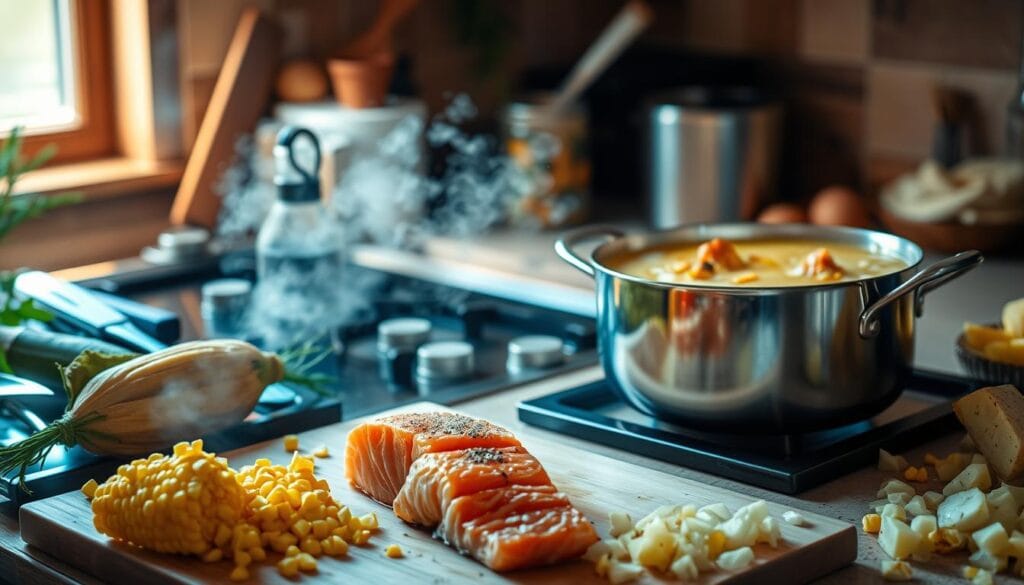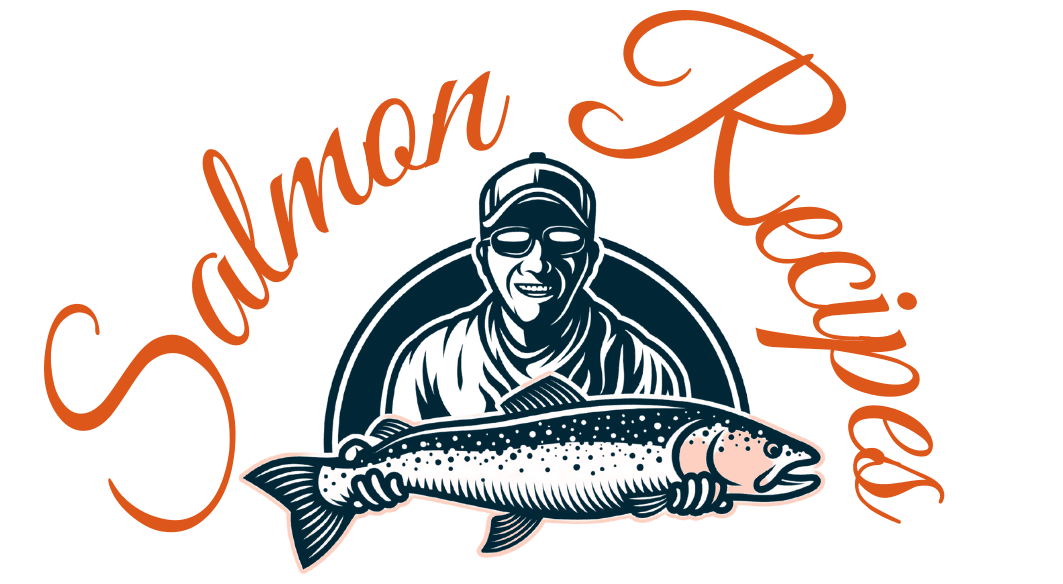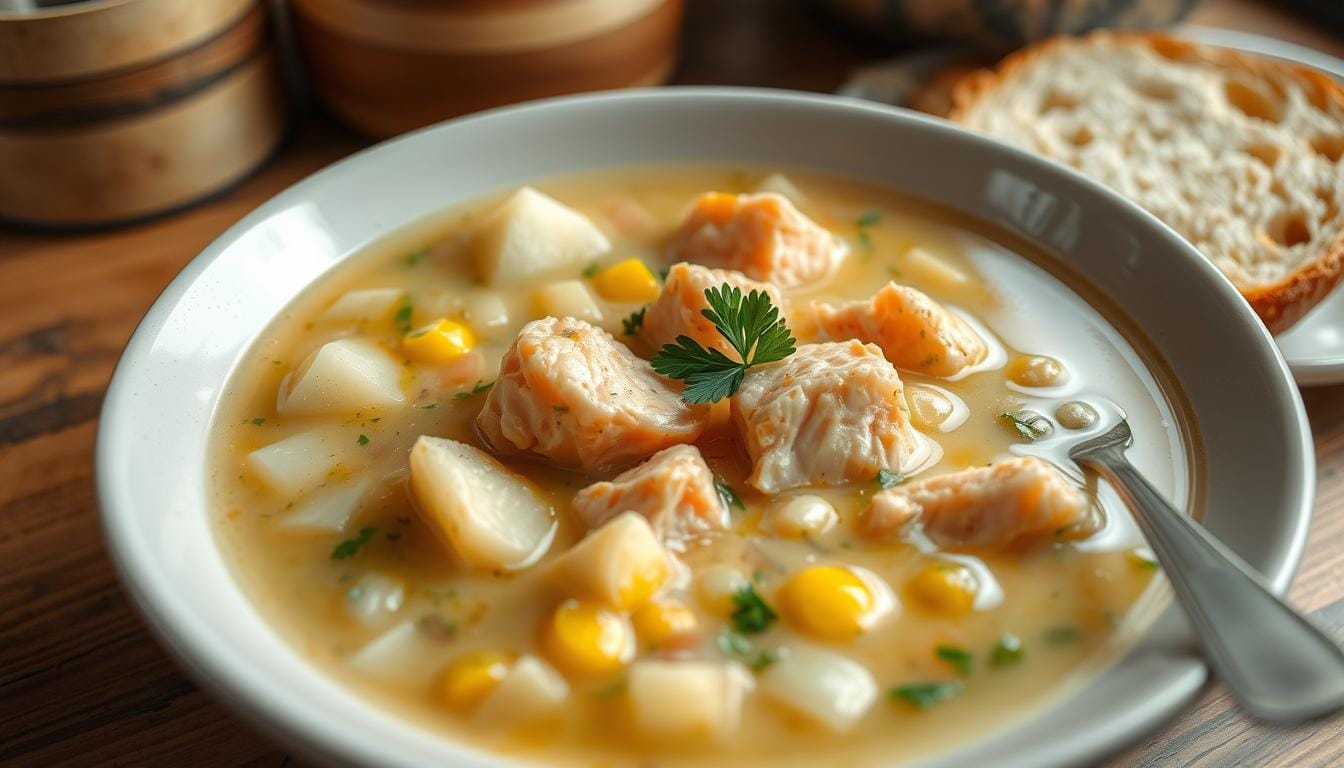Explore the world of salmon chowder, a hearty fish soup that warms your heart. It’s a classic dish that mixes tender salmon, creamy broth, and fresh veggies. This combo creates a delicious meal that fills your belly and satisfies your taste buds.
Your journey into salmon chowder starts with a creamy base. This base lets the fresh salmon shine. Unlike other fish soups, this recipe balances textures and tastes perfectly, making your cooking at home special.
This fish soup is made with the best ingredients, serving 4-6 people. It has crispy bacon and perfectly cooked salmon. Every bite is a story of great cooking and home-style meals.
Looking for a cozy dinner or a dish to impress at gatherings? Salmon chowder is your go-to. It will make your taste buds happy and warm your soul. Get ready for a tasty journey that celebrates seafood cooking at its best.
Table of Contents
Introduction to Classic Salmon Chowder
Seafood stew lovers and soup fans, get ready for a culinary adventure. Creamy salmon chowder is more than a meal. It’s a journey through tradition and nutrition.
Origins of Seafood Chowders
Chowders come from coastal fishing communities in North America. Fishermen made these soups to use fresh catch and stay warm during long sea trips. Over time, these simple soups became a sophisticated culinary art.
- Early chowders used local fish and shellfish
- Coastal areas like New England perfected the recipe
- Techniques were passed down through maritime families
Why This Recipe Stands Out
Our creamy salmon chowder is special because of its rich flavors and careful making. It’s different from other seafood stews. It balances delicate salmon with a creamy base, making it a gourmet treat.
Health Benefits of Salmon-Based Soups
Salmon is very nutritious. It has about 22g of protein and omega-3 fatty acids good for the heart and brain. Nutritionists say salmon-based dishes are great for health.
“A bowl of salmon chowder is more than comfort food – it’s a nutritional powerhouse.” – Culinary Health Magazine
This salmon chowder combines tradition, flavor, and nutrition. It’s a delightful journey that feeds both body and soul.
Essential Ingredients for Perfect Salmon Chowder
Making a true New England salmon chowder means picking top-notch ingredients. These ingredients should work together to make a dish that’s both rich and satisfying. Your journey starts with knowing the key parts that turn simple items into a memorable seafood dish.
The base of a great New England salmon chowder is fresh, quality ingredients. Chefs say to focus on these key items:
- Fresh Salmon: Wild-caught or fresh Atlantic salmon, preferably skin-on fillets
- Thick-cut bacon for smoky depth
- Russet or Yukon Gold potatoes
- Sweet corn kernels
- Heavy cream for luxurious texture
- Fresh herbs like dill and parsley
Knowing how each ingredient adds to the chowder is key. Salmon gives protein and flavor, while potatoes make it hearty. Bacon adds a smoky taste that makes the dish better.
“A great chowder is about balance – no single ingredient should overpower another.” – Northeast Seafood Culinary Institute
| Ingredient | Quantity (4 servings) | Nutritional Impact |
|---|---|---|
| Salmon Fillets | 12 oz | 23g Protein, 110mg Cholesterol |
| Heavy Cream | ⅔ cup | 14g Saturated Fat |
| Potatoes | 2 medium | 34g Carbohydrates |
| Bacon | 4 slices | 7g Fat |
How well your New England salmon chowder turns out depends on the quality and how you prepare the ingredients. Always choose fresh, local ingredients for the best taste and authenticity.
Kitchen Tools and Equipment Needed
Making a tasty salmon bisque needs the right kitchen tools. The right equipment can make cooking better and the dish more delicious. Let’s look at the cookware and utensils you’ll need for this comforting dish.
Essential Cookware for Salmon Bisque
Start by picking the right cookware for your salmon bisque. A heavy-bottomed stockpot is key for even heat and to avoid scorching. Choose a pot that’s at least 5-6 quarts to hold all your ingredients well.
- Large heavy stockpot (5-6 quarts)
- Dutch oven with thick base
- Sturdy wooden spoon
- Sharp chef’s knife
- Cutting board
Optional Cooking Utensils
Some utensils can make preparing salmon bisque better, even if they’re not necessary:
- Immersion blender for smooth texture
- Fish spatula for delicate salmon handling
- Measuring cups and spoons
- Ladle for serving
Storage Containers
Storing your salmon bisque right keeps it fresh and tasty:
| Container Type | Best For | Storage Duration |
|---|---|---|
| Glass containers with tight lids | Refrigeration | 3-4 days |
| Freezer-safe plastic containers | Long-term storage | 2-3 months |
“Good tools are half the battle in creating a perfect salmon bisque.” – Professional Chef
Investing in quality kitchen equipment can make your salmon bisque amazing. Remember, the right tools make cooking not just easier, but more fun.
Preparing the Base: Bacon and Vegetables
Starting a delicious smoked salmon chowder begins with a flavorful base. It’s all about crispy bacon and its fat for cooking veggies. This mix adds depth and complexity to the dish.
First, cook 4 strips of bacon until they’re brown and crispy. This takes about 5-10 minutes. The bacon fat is perfect for cooking your veggies.
- Remove the crispy bacon and set aside
- Keep the bacon fat in the pot for sautéing
- Add 2 tablespoons of butter for extra richness
For the vegetable base, you need a mix of flavors. Here’s what you’ll use:
| Vegetable | Quantity | Preparation |
|---|---|---|
| Yellow Onion | 1 medium | Diced |
| Celery | 2 stalks | Chopped |
| Baby Carrots | 10 | Sliced |
| Garlic | 1 tablespoon | Minced |
Cook these veggies in the bacon fat and butter for 5-6 minutes. They should be soft and fragrant. This step makes your chowder special.
“The magic of a great chowder is in its base – take your time and let the flavors develop.” – Coastal Cooking Wisdom
Season the veggies with ½ teaspoon of salt, ⅛ teaspoon of black pepper, and a pinch of dried herbs. This will boost the taste of your smoked salmon chowder.
Creating the Creamy Broth Foundation
Making the perfect chunky salmon chowder starts with a rich, flavorful broth. This broth is the heart of your dish. It’s all about building depth and a creamy texture that will make your chowder unforgettable.
Proper Thickening Techniques
When making your chunky salmon chowder, you need to know two main thickening methods:
- Roux Method: Mix equal parts butter and flour, cooking until golden
- Cornstarch Slurry: Mix cornstarch with cold liquid before adding to hot broth
The roux method gives a lighter, velvety texture. Use a 3:1 ratio of cream to whole milk for a smooth consistency.
Incorporating Dairy Elements
Choosing the right dairy is key for your chunky salmon chowder. Use milk with 3.25% fat or higher to avoid splitting when heated. Full-fat sour cream adds richness.
“The key to a perfect chowder is balancing flavors and maintaining a silky smooth texture.”
Seasoning Tips
Enhance your broth with the right seasonings. Mix chicken broth with clam juice for a deeper flavor. Include:
- Fresh herbs like dill or parsley
- Bay leaves for depth
- Salt and pepper to taste
Pro tip: Sweat your vegetables for 10-15 minutes. This builds a robust flavor foundation that makes your chunky salmon chowder stand out.
Adding the Star Ingredient: Cooking Perfect Salmon

Choosing the right salmon is key for a great salmon corn chowder. Fresh salmon offers the best flavor, but frozen salmon can also be good. Make sure your salmon is cooked just right for the best taste and texture.
To get amazing salmon in your chowder, start by drying it with paper towels. This helps get a nice sear. Season it with salt, pepper, and a bit of dill to boost its flavor.
“The secret to perfect salmon is minimal cooking and maximum flavor” – Coastal Cooking Experts
Salmon Preparation Techniques
- Choose fresh Norwegian salmon filets (2 lbs recommended)
- Pat salmon dry to remove excess moisture
- Season with salt, pepper, and herbs
- Sear briefly to develop a golden crust
Cooking Guidelines
| Cooking Method | Temperature | Cooking Time |
|---|---|---|
| Searing | Medium-high heat | 2-3 minutes total |
| Chowder Cooking | Gentle simmer | 3-4 minutes |
| Internal Temperature | 145°F | Fully cooked |
When adding salmon to your corn chowder, gently fold it in during the last few minutes. This keeps the salmon tender. Cook it until it’s just opaque and flakes easily.
Pro tip: If using canned salmon, cook it for just 1 minute to avoid toughness. Fresh salmon needs about 3-4 minutes in the hot chowder to be perfectly done.
Incorporating Potatoes and Corn
Choosing the right potatoes and corn is key to making a great salmon potato chowder. These ingredients add a rich texture and flavor to your dish.
Selecting the Perfect Potatoes
Russet potatoes are the best choice for your chowder. They break down during cooking, thickening the chowder. Here are some tips for preparing potatoes:
- Cut potatoes into uniform 1/3 to 1/2 inch cubes
- Aim for consistent sizing to ensure even cooking
- Leave the skin on for added texture and nutrients
Fresh vs. Frozen Corn Considerations
Both fresh and frozen corn can be used in your salmon potato chowder. Each type offers its own benefits.
| Corn Type | Pros | Cons |
|---|---|---|
| Fresh Corn | Vibrant flavor, crisp texture | Seasonal availability, more preparation time |
| Frozen Corn | Convenient, consistent quality | Slightly softer texture |
Use 1.5 cups of corn, whether it’s fresh or frozen. If using fresh corn, blanch the kernels briefly to bring out their sweetness.
“The right potatoes and corn can transform a simple chowder into a memorable meal.” – Culinary Chef
Storage and Reheating Guidelines

Keeping your homemade salmon chowder fresh is key. Follow these tips to enjoy it for longer. Your fish soup will stay tasty and safe to eat.
Refrigerator Storage
Put your chowder in an airtight container to keep it fresh. It’s best to store it in the fridge for up to 3 days. Don’t let it sit out for too long.
- Use glass or high-quality plastic containers with tight-fitting lids
- Cool the chowder completely before refrigerating
- Keep the container sealed to prevent flavor absorption
Freezing Your Fish Soup
Freezing is a great way to keep your chowder fresh. It can stay good for up to 2 months in the freezer.
- Use freezer-safe containers or heavy-duty freezer bags
- Leave some space at the top for expansion
- Label containers with the date of preparation
Reheating Techniques
Reheating your fish soup gently is important. It helps keep the creamy texture and prevents it from separating. You can use two main methods:
- Stovetop Method: Reheat on medium-low heat, stirring occasionally
- Microwave Method: Heat in short intervals, stirring between each
“The key to a perfect reheated chowder is patience and low, consistent heat.”
Pro tip: If your chowder is too thick after chilling, add a bit of fish stock or cream. It will get back to its original consistency.
Conclusion
Your salmon chowder journey doesn’t end with the last spoonful. It’s more than a recipe—it’s a culinary adventure. It connects nutrition, flavor, and home cooking.
With 24 grams of protein and omega-3 fatty acids in each serving, it’s a health investment. You’re not just preparing a meal, but also caring for your health.
Experimenting with this seafood stew lets you get creative. You can use smoked salmon, fresh catch, or adapt it for dietary needs. The possibilities are endless.
The recipe’s flexibility means you can customize it to your taste. You can keep its core nutritional benefits while making it your own.
Sharing this chowder with friends and family makes it a memorable dining experience. Pair it with a crisp Sauvignon Blanc or crusty bread for a delightful meal. Your homemade salmon chowder is a celebration of fresh ingredients, culinary skill, and the joy of cooking.
With just 40 minutes of preparation and cooking time, you can make a nutritious, delicious seafood stew. Impress and nourish your loved ones with your culinary creativity.
FAQ
What makes salmon chowder different from other seafood soups?
Salmon chowder is special because of its creamy base and the unique taste of salmon. It has chunks of fresh salmon, potatoes, and sometimes bacon. This makes it a hearty dish with a rich flavor, unlike other seafood soups.
Can I use frozen salmon for the chowder?
Yes, frozen salmon works well for chowder. Make sure it’s thawed and dried before cooking. Fresh salmon is best for flavor, but frozen salmon is convenient. Just cook it gently to keep it tender.
How long can I store salmon chowder in the refrigerator?
You can keep salmon chowder in the fridge for 3-4 days in an airtight container. Reheat it gently to avoid tough fish and separated cream. Reheat only what you plan to eat to keep it fresh.
Is salmon chowder healthy?
Salmon chowder can be healthy. Salmon has omega-3s good for your heart and brain. But, cream and bacon make it high in calories. Use low-fat milk, less cream, and lean bacon to make it healthier.
Can I make a dairy-free version of salmon chowder?
Yes! For a dairy-free version, use coconut milk or almond milk instead of cream. Use vegetable broth instead of milk. This way, you can enjoy a creamy chowder that fits your diet.
What are the best potatoes to use in salmon chowder?
Russet potatoes are best for chowder because they thicken the broth. Yukon Gold potatoes are also great for their buttery taste. Avoid waxy potatoes for the right creamy texture.
Can I freeze salmon chowder?
Freezing salmon chowder is possible, but it might change texture. Cream-based soups can become grainy when thawed and reheated. Cool it completely, store in an airtight container, and thaw in the fridge. Reheat gently to restore its creamy texture.

